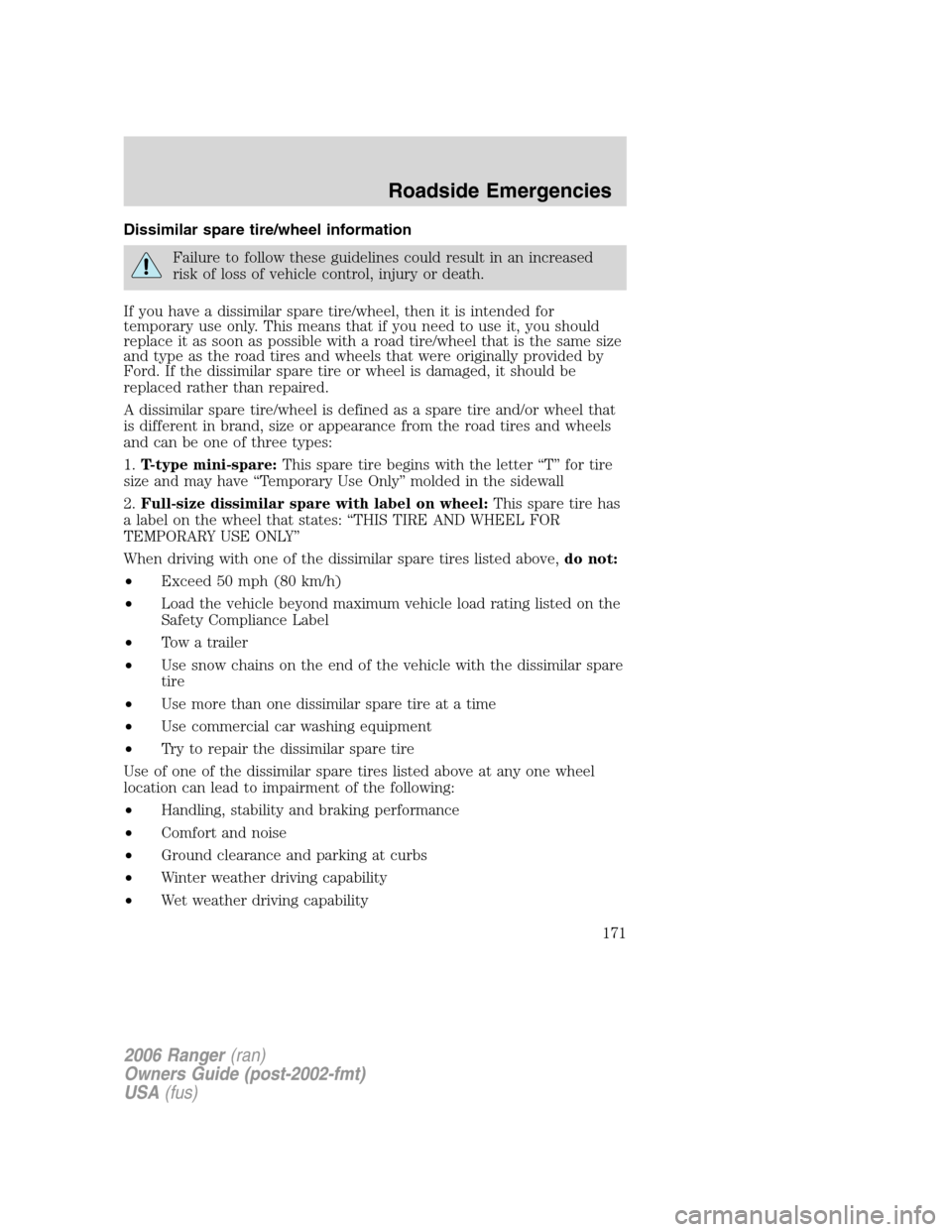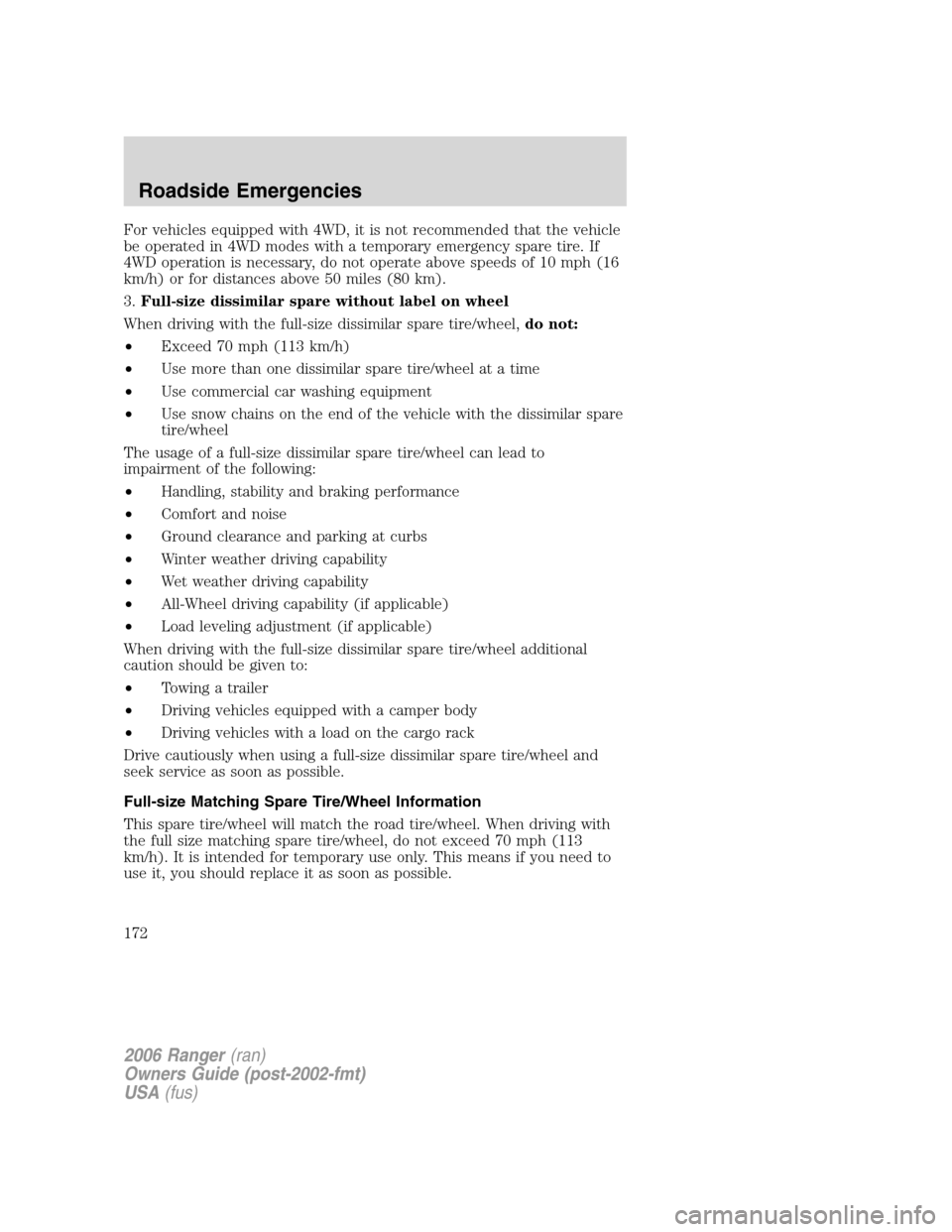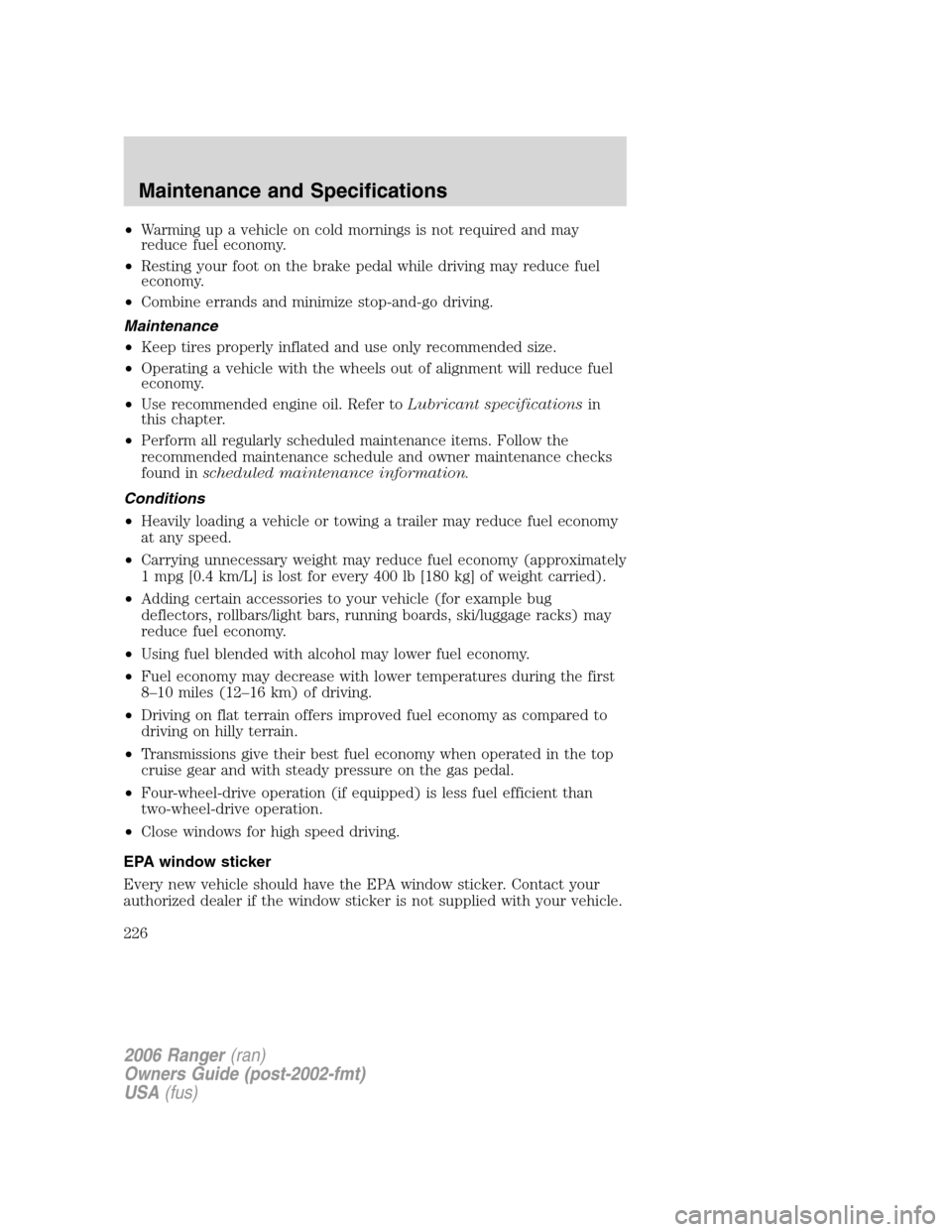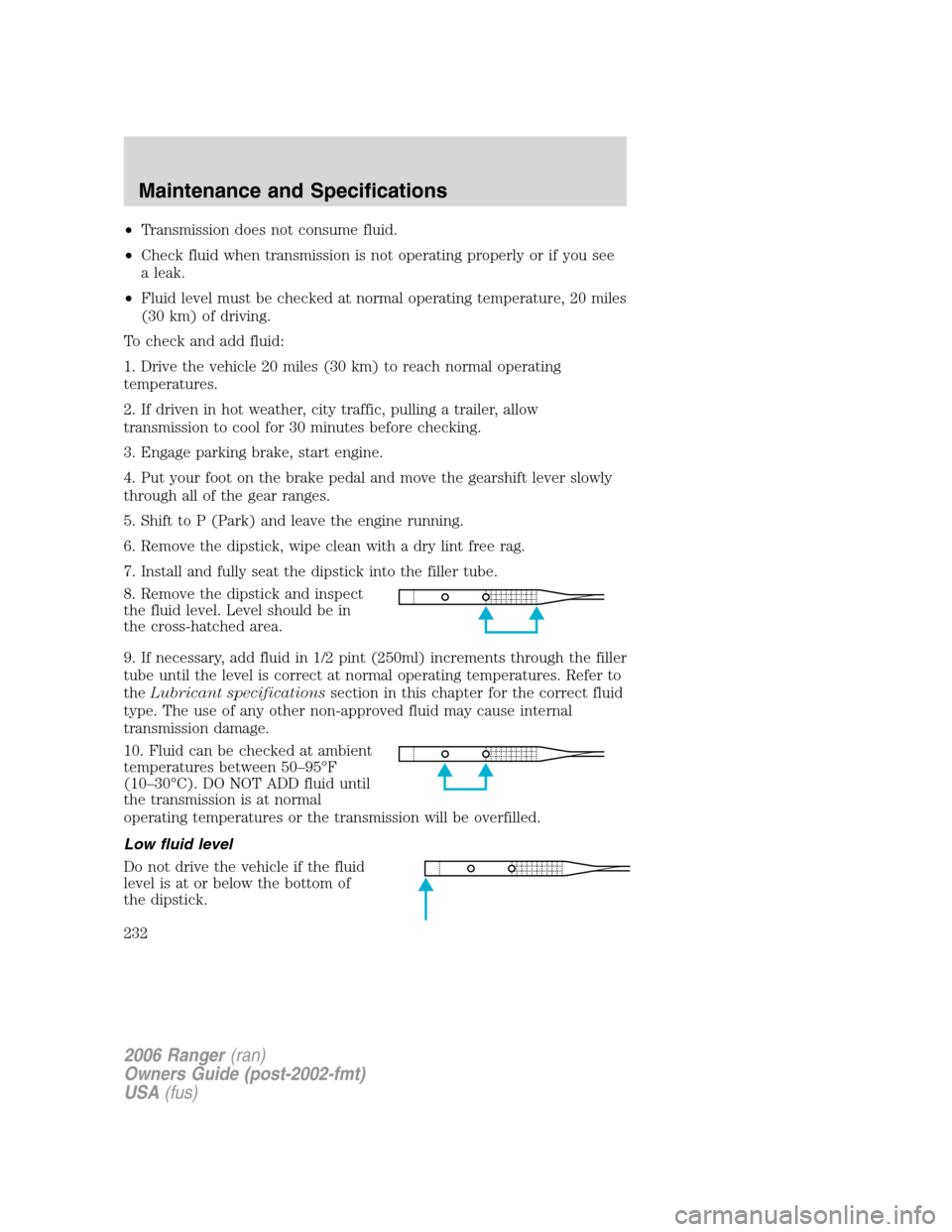2006 FORD RANGER trailer
[x] Cancel search: trailerPage 169 of 256

Fuse/Relay
LocationFuse Amp
RatingPower Distribution Box
Description
14 — Not used
15 — Not used
16 — Not used
17 40A** ABS (motor)
18 — Not used
19 — Not used
20 — Not used
21 10A* PCM keep alive power
22 — Not used
23 20A* Fuel pump
24 — Not used
25 10A* A/C clutch solenoid
26 — Not used
27 20A* 4x4 module
28 — Not used
29 — Not used
30 — Not used
31 15A* Foglamps
32 — Not used
33 30A* Anti-lock Brake System (ABS)
(solenoids)
34 — Not used
35 — Not used
36 — Not used
37 — Not used
38 7.5A* Trailer tow (right turn)
39 — Not used
40 — Not used
2006 Ranger(ran)
Owners Guide (post-2002-fmt)
USA(fus)
Roadside Emergencies
169
Page 170 of 256

Fuse/Relay
LocationFuse Amp
RatingPower Distribution Box
Description
41 15A* Heated Exhaust Gas Oxygen
(HEGO) sensors, EVAP canister
vent valve, Exhaust Gas
Recirculation (EGR) stepper
motor, Transmission
42 7.5A* Trailer tow (left turn)
43 — Not used
44 — Not used
45A — Wiper HI/LO relay
45B — Wiper Park/Run relay
46A — A/C clutch solenoid
46B — Washer pump relay
47 — PCM relay
48A — Fuel pump relay
48B — Fog lamp relay
51 — Not used
52 — Not used
53 — Not used
54 — Not used
55 — Blower relay
56 — Starter relay
* Mini Fuses ** Maxi Fuses
CHANGING THE TIRES
If you get a flat tire while driving:
•do not brake heavily.
•gradually decrease the vehicle’s speed.
•hold the steering wheel firmly.
•slowly move to a safe place on the side of the road.
The use of tire sealants is not recommended and may damage
your tires.
2006 Ranger(ran)
Owners Guide (post-2002-fmt)
USA(fus)
Roadside Emergencies
170
Page 171 of 256

Dissimilar spare tire/wheel information
Failure to follow these guidelines could result in an increased
risk of loss of vehicle control, injury or death.
If you have a dissimilar spare tire/wheel, then it is intended for
temporary use only. This means that if you need to use it, you should
replace it as soon as possible with a road tire/wheel that is the same size
and type as the road tires and wheels that were originally provided by
Ford. If the dissimilar spare tire or wheel is damaged, it should be
replaced rather than repaired.
A dissimilar spare tire/wheel is defined as a spare tire and/or wheel that
is different in brand, size or appearance from the road tires and wheels
and can be one of three types:
1.T-type mini-spare:This spare tire begins with the letter “T” for tire
size and may have “Temporary Use Only” molded in the sidewall
2.Full-size dissimilar spare with label on wheel:This spare tire has
a label on the wheel that states: “THIS TIRE AND WHEEL FOR
TEMPORARY USE ONLY”
When driving with one of the dissimilar spare tires listed above,do not:
•Exceed 50 mph (80 km/h)
•Load the vehicle beyond maximum vehicle load rating listed on the
Safety Compliance Label
•Tow a trailer
•Use snow chains on the end of the vehicle with the dissimilar spare
tire
•Use more than one dissimilar spare tire at a time
•Use commercial car washing equipment
•Try to repair the dissimilar spare tire
Use of one of the dissimilar spare tires listed above at any one wheel
location can lead to impairment of the following:
•Handling, stability and braking performance
•Comfort and noise
•Ground clearance and parking at curbs
•Winter weather driving capability
•Wet weather driving capability
2006 Ranger(ran)
Owners Guide (post-2002-fmt)
USA(fus)
Roadside Emergencies
171
Page 172 of 256

For vehicles equipped with 4WD, it is not recommended that the vehicle
be operated in 4WD modes with a temporary emergency spare tire. If
4WD operation is necessary, do not operate above speeds of 10 mph (16
km/h) or for distances above 50 miles (80 km).
3.Full-size dissimilar spare without label on wheel
When driving with the full-size dissimilar spare tire/wheel,do not:
•Exceed 70 mph (113 km/h)
•Use more than one dissimilar spare tire/wheel at a time
•Use commercial car washing equipment
•Use snow chains on the end of the vehicle with the dissimilar spare
tire/wheel
The usage of a full-size dissimilar spare tire/wheel can lead to
impairment of the following:
•Handling, stability and braking performance
•Comfort and noise
•Ground clearance and parking at curbs
•Winter weather driving capability
•Wet weather driving capability
•All-Wheel driving capability (if applicable)
•Load leveling adjustment (if applicable)
When driving with the full-size dissimilar spare tire/wheel additional
caution should be given to:
•Towing a trailer
•Driving vehicles equipped with a camper body
•Driving vehicles with a load on the cargo rack
Drive cautiously when using a full-size dissimilar spare tire/wheel and
seek service as soon as possible.
Full-size Matching Spare Tire/Wheel Information
This spare tire/wheel will match the road tire/wheel. When driving with
the full size matching spare tire/wheel, do not exceed 70 mph (113
km/h). It is intended for temporary use only. This means if you need to
use it, you should replace it as soon as possible.
2006 Ranger(ran)
Owners Guide (post-2002-fmt)
USA(fus)
Roadside Emergencies
172
Page 226 of 256

•Warming up a vehicle on cold mornings is not required and may
reduce fuel economy.
•Resting your foot on the brake pedal while driving may reduce fuel
economy.
•Combine errands and minimize stop-and-go driving.
Maintenance
•Keep tires properly inflated and use only recommended size.
•Operating a vehicle with the wheels out of alignment will reduce fuel
economy.
•Use recommended engine oil. Refer toLubricant specificationsin
this chapter.
•Perform all regularly scheduled maintenance items. Follow the
recommended maintenance schedule and owner maintenance checks
found inscheduled maintenance information.
Conditions
•Heavily loading a vehicle or towing a trailer may reduce fuel economy
at any speed.
•Carrying unnecessary weight may reduce fuel economy (approximately
1 mpg [0.4 km/L] is lost for every 400 lb [180 kg] of weight carried).
•Adding certain accessories to your vehicle (for example bug
deflectors, rollbars/light bars, running boards, ski/luggage racks) may
reduce fuel economy.
•Using fuel blended with alcohol may lower fuel economy.
•Fuel economy may decrease with lower temperatures during the first
8–10 miles (12–16 km) of driving.
•Driving on flat terrain offers improved fuel economy as compared to
driving on hilly terrain.
•Transmissions give their best fuel economy when operated in the top
cruise gear and with steady pressure on the gas pedal.
•Four-wheel-drive operation (if equipped) is less fuel efficient than
two-wheel-drive operation.
•Close windows for high speed driving.
EPA window sticker
Every new vehicle should have the EPA window sticker. Contact your
authorized dealer if the window sticker is not supplied with your vehicle.
2006 Ranger(ran)
Owners Guide (post-2002-fmt)
USA(fus)
Maintenance and Specifications
226
Page 232 of 256

•Transmission does not consume fluid.
•Check fluid when transmission is not operating properly or if you see
a leak.
•Fluid level must be checked at normal operating temperature, 20 miles
(30 km) of driving.
To check and add fluid:
1. Drive the vehicle 20 miles (30 km) to reach normal operating
temperatures.
2. If driven in hot weather, city traffic, pulling a trailer, allow
transmission to cool for 30 minutes before checking.
3. Engage parking brake, start engine.
4. Put your foot on the brake pedal and move the gearshift lever slowly
through all of the gear ranges.
5. Shift to P (Park) and leave the engine running.
6. Remove the dipstick, wipe clean with a dry lint free rag.
7. Install and fully seat the dipstick into the filler tube.
8. Remove the dipstick and inspect
the fluid level. Level should be in
the cross-hatched area.
9. If necessary, add fluid in 1/2 pint (250ml) increments through the filler
tube until the level is correct at normal operating temperatures. Refer to
theLubricant specificationssection in this chapter for the correct fluid
type. The use of any other non-approved fluid may cause internal
transmission damage.
10. Fluid can be checked at ambient
temperatures between 50–95°F
(10–30°C). DO NOT ADD fluid until
the transmission is at normal
operating temperatures or the transmission will be overfilled.
Low fluid level
Do not drive the vehicle if the fluid
level is at or below the bottom of
the dipstick.
2006 Ranger(ran)
Owners Guide (post-2002-fmt)
USA(fus)
Maintenance and Specifications
232
Page 249 of 256

Tonneau covers
Wheels
Interior style
Electrochromatic compass/temperature interior mirrors
Floor mats
Leather wrapped steering wheels
Speed control
Lifestyle
Bed extender
Bedliners and bedmats
Bed tents
Bike racks
Neutral tow kit
Sport liner
Trailer hitches, wiring harnesses and accessories
Peace of mind
First aid and highway safety kits
Full vehicle covers
Locking gas cap
Remote start
Vehicle security systems
Keyless entry keypad
For maximum vehicle performance, keep the following information in
mind when adding accessories or equipment to your vehicle:
•When adding accessories, equipment, passengers and luggage to your
vehicle, do not exceed the total weight capacity of the vehicle or of
the front or rear axle (GVWR or GAWR as indicated on the Safety
Compliance Certification label). Consult your authorized dealer for
specific weight information.
2006 Ranger(ran)
Owners Guide (post-2002-fmt)
USA(fus)
Accessories
249
Page 255 of 256

Seats ............................................64
child safety seats ......................92
Servicing your vehicle ..............199
Setting the clock
AM/FM stereo ...........................18
AM/FM stereo CD .....................20
AM/FM stereo tape/CD/MP3 ....23
Premium AM/FM stereo
CD6/MP3 ...................................27
Snowplowing .................................8
Spark plugs, specifications ......236,
243
Special notice
ambulance conversions ..............9
utility-type vehicles ....................8
Specification chart,
lubricants ...........................240, 243
Speed control ..............................52
Starting your
vehicle ........................135–136, 138
jump starting ..........................178
Steering wheel
tilting .........................................49
T
Tilt steering wheel ......................49
Tires ...........................103–104, 170
alignment ................................110
care ..........................................108
changing ..........................170, 175
checking the pressure ............108
inspecting and inflating .........105
label .........................................116
replacing ..................................109
rotating ....................................111
safety practices .......................110
sidewall information ...............112
snow tires and chains ............117spare tire .........................171–172
terminology .............................105
tire grades ...............................104
treadwear ........................104, 108
Towing .......................................124
recreational towing .................133
trailer towing ..........................124
wrecker ....................................184
Traction-lok rear axle ...............141
Transfer case
fluid checking .........................234
Transmission
automatic operation ...............142
brake-shift interlock (BSI) ....142
fluid, checking and adding
(manual) .................................233
fluid, refill capacities ..............237
lubricant specifications ..240, 243
manual operation ....................145
Turn signal ..................................42
V
Vehicle dimensions ...................243
Vehicle Identification Number
(VIN) ..........................................246
Vehicle loading ..........................117
camper bodies ........................156
Ventilating your vehicle ...........138
W
Warning lights (see Lights) .......12
Washer fluid ..............................204
Water, Driving through .............156
Windows
power .........................................51
2006 Ranger(ran)
Owners Guide (post-2002-fmt)
USA(fus)
Index
255